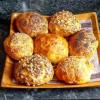
Converting crushed red rye crystal to red rye malt
Is this possible?
Doug

Is this possible?
Doug

Hi! I’m new here but have been browsing the forums for about a week now. I’m currently in the process of baking a batard for the first time in a clay pot. It’s a Schlemmertopf, glazed bottom. I came here looking for answers on how the heck to use this thing. No one, and I mean no one has agreed on or used there’s the same. It’s rather frustrating as my batard is on its final rise. There just doesn’t seem to be a concrete answer.
I soak, I don’t , skip the soak, put it in a cold oven, preheat the oven, don’t drop cold dough in it, be careful of water on hot pot, soak lid but don’t soak bottom, soak bottom but don’t soak lid, soak both, turn upside down to cook in it, soak 10 minutes, soak thirty, let preheat in oven on low adjust to baking temperature after 15 minutes. Good grief!
I feel more confused than ever. I don’t even want to cook in it at this point. Why isn’t there just “a way” that works, that doesn’t crack the pot, that everyone agrees on?
I understand different techniques produce different results but this is just too much for my brain at the moment. At this point I plan to do the soak, preheat the oven with both soaked lid and top inside the oven so it gradually reaches temperature and doesn’t get shocked. I prefer (hand burns and all) to drop my (by way of parchment paper) room temperature dough into a preheated pot then put the lid on and cook the bread for about 30 minutes and check it, maybe cook more with lid off. I feel like I’ve gone mad reading all the different techniques to the point of not knowing what to do.


I finally got close to where I want to be with ciabattas!
I was going to a friend's flat for an Italian dinner yesterday, so decided to bring a ciabatta, although previously I only had partial success with this style of bread. However Rus Brot has a video recipe for ciabatta, and so far each and every recipe of his have been a great success, so I decided to risk it. The video is unfortunately only in Russian: https://youtu.be/beEhMiwIaHw
Here is the formula, except I increased the amount of CLAS to 5% by flour weight, since my bread flour is a little higher ash, probably: https://fgbc.dk/1so4
In addition, I replaced 20% of the flour with semola rimacinata, since I need to use it up soon, and seemed like a fitting bread to add it to.
The process is very simple. The dough is mixed using cold CLAS and cold water (I used, like him, a hand-held mixer with spiral attachments), and oil and some water are withheld. Then after partial development oil is incorporated, and then the remaining water, until very soft consistency - around 80% hydration in my case, all the while developing the gluten. DDT of about 25°C. Then the dough is transferred into a rectangular contained. Folded after 1 hr, and then it goes into the fridge for ~24 hrs. About half-way through cold bulk it's folded again. Before baking it's warmed up at RT for 1.5 hrs. Then in the recipe he does a few folds before dividing the dough and coaxing it into rectangle. I decided to skip the folds at this stage as I felt they would impede open crumb formation, and simply divided the dough in half. It's then proofed at RT for 20-30 min, and baked. I proofed on a couche, and flipped upside down when transferring onto a peel - like you'd do with baguettes. The very tip of one of them got a little stuck on the peel unfortunately, and I think it deflated that half of the bread a little. So I brought the other one to the dinner party. Baked for about 15 min with steam on steel, and then until I liked the colour without steam.
They looked stunning, even is I say so myself, with the beautiful pattern of flour on the crust. Crust was super hard and crispy out of the oven, and stayed so for a little while, but it's always lost here with the humidity we are having. I think addition of a little durum also helped with that.
My friend took a couple of pictures of the food, which included the sliced ciabatta. Shows quite clearly that in some spots it had huge bubbles under the crust, despite being flipped before loading into the oven. Perhaps they could benefit from some light docking, but they were already huge and would barely fit on my steel, if they ended up being any longer it would be a problem.
Here is the crumb of the one I kept at home. It's a bit different in different parts of the bread, some parts more open than others. But I'm not complaining.
And it's delicious! It's awesome how easy it is to bake with just yeast for leavening, and CLAS provides such pleasant flavour. No overt acidity, but a nice lingering pleasant aftertaste, a bit similar flavour to when I tried making ciabatta with a SD biga back during the CB. Nicely caramelized crust. Light and fluffy crumb. I'm very pleased with this.

Hey bakers! I have a question for anyone who is kind enough to answer! Where is your favorite warm spot to let your dough rise (when you're specifically looking for a warm place)?
Is it on top of your fridge? In your turned-off oven? Next to a heater? Something else?
I'm doing a little research for my blog and I'd love to know where home bakers go when they're looking for a warm spot in their house. Thanks so much in advance for your answers!
Best,
Grant
P.S. I know cold-proofing is amazing - but that's a topic for a different day.

Rosemary & Walnut Schiacciata From Living Bread by Daniel Leader
This is the 2nd time making this bread and it was a hit both times. It has a wonderful walnut taste and combined with the rosemary and olive oil it is delicious.
Recipe and process are below.
Tony

I recently made a sourdough version of Peter Reinhart's Poor Man's Brioche from BBA.
Here is the formula:
I fed the starter the night before baking around 9:30. I started the mix at 8:30 the next day. I may try a stiff overnight levain next time I bake this bread.
I started by mixing the starter, eggs, and water together. Next I added all the ingredients except the butter and mixed for about ten minutes. After a 20 minute rest I added about a third of the butter and mixed for about 10 minutes. I continued in this fashion until all the butter was added. The FDT was about 82 degrees Fahrenheit.
I bulked for about 4 and a half hours. I shaped the dough into a boule and let it rest for about 20 minutes, and then shaped it into a loaf. The second proof lasted about 6.5 hours. I used my oven light to keep the dough nice and warm.
I baked the bread at 350 degrees Fahrenheit for 30 minutes. This was too long. The temp was about 207 degrees Fahrenheit.
Here is the final result. The bread was too small for the loaf pan I used. I'll probably increase the recipe by 50% next time I bake this bread.



Any feedback is appreciated!

Apparently this bread is also known as tourte Auvergnate. It is a 100% whole rye loaf and mine was made without any commercial yeast although I’ve seen recipes that use it in as a sponge along with the rye sour. Those who are familiar with baking rye sourdoughs know that they ferment very quickly. From building the first stage of the rye levain until the loaf is out of the oven only took 18 hours. However, you’re also likely aware that rye breads need time to “cure” after baking so I think they are best if you wait 24-48 hours before slicing. Based on my first bake of a 100% rye loaf I will wait 48 hours because I found that the rye flavour was more pronounced at 48 compared with 24 hours, and if you’re baking a 100% rye sourdough you want to taste the rye, no?
When recipes for rye say to flour the countertop or your hands, they do mean generously. At the time of shaping I didn’t have quite enough flour down and was getting a ton of sticking. Fortunately if you have your dough scraper handy, and of course you would, it is easy enough to get more flour under that sticky dough. I use the word shape loosely because really you’re molding the dough into a boule. Forget trying to create any tension, there isn’t the gluten of wheat in this dough so really you’re moulding it like clay.
| Rye %: | 100% |
|---|---|
| Stages: | Stage 1 sponge, Stage 2 sponge, Final dough |
| Leaven: | Rye sour culture |
| Start to Finish: | 14-16 hours |
| Hands-on Time: | 25-30 minutes |
| Yield: | Two 1¾ lb/800 g loave |
Stage 1 sponge (Day 1, Evening):
Ingredient Grams 2x800g loaves 1x900 g loaf (0.5625) Baker’s
Percentage
Wholegrain rye flour 118 66 g 100%
Warm (105°F/41°C) water 118 66 g 100%
Rye sour culture 14 8 g 12%
Mix the sponge ingredients by hand, cover and ferment at room temperature (70°F/21°C) overnight, 10-12 hours. The sponge will have tripled in volume and be very bubbly.
Stage 2 sponge (Day 2, Morning):
Ingredient Grams 2x800 g loaves 1x900 g loaf Baker’s
Percentage
Stage 1 sponge 250 140 g 100%
Wholegrain rye flour 250 140 g 100%
Warm (105°F/41°C) water 250 140 g 100%
Combine the Stage 1 sponge and the Stage 2 ingredients in the mixer bowl, cover and ferment at room temperature until the dough has visibly expanded and shows cracks or broken bubbles, 1½-2 hours.
Final Dough (Day 2, Midday):
| Ingredient | Grams 2x800 g | 1x940 g loaf |
|---|---|---|
| Stage 2 sponge | 750 | 420 g |
| Wholegrain rye flour | 500 | 281 g |
| Warm (105°F/41°C) water | 425 | 239 g |
| Salt | 10 | 5.625 |
Combine the Stage 1 sponge and the Stage 2 ingredients in the mixer bowl, cover and ferment at room temperature until the dough has visibly expanded and shows cracks or broken bubbles, 1½-2 hours.
Final Dough (Day 2, Midday):
| Ingredient | Grams 2x800 g | 1x940 g loaf |
|---|---|---|
| Stage 2 sponge | 750 | 420 g |
| Wholegrain rye flour | 500 | 281 g |
| Warm (105°F/41°C) water | 425 | 239 g |
| Salt | 10 | 5.625 |
In the mixer bowl, combine the final dough ingredients and use the dough hook at low (KA2) speed to mix until fully blended into a soft, sticky dough that gathers around the hook but doesn’t leave the sides of the bowl, 5-6 minutes.
Cover the bowl and ferment at room temperature until the dough doubles in volume and shows cracks or broken bubbles, 1½-2 hours.
Turn the dough onto a well-floured work surface. Use floured hands to gently shape into a boule, then place boule seam side up in a floured linen-lined banneton or cloth-lined proofing basket. Cover and proof at room temperature until the dough has visibly expanded and shows cracks or broken bubbles, 20-30 minutes.
Preheat the oven to 445°F/230°C with the baking surface in the middle. Turn the loaf onto a well-floured peel, if using a baking stone, or a parchment-lined sheet pan.
Bake without steam for 15 minutes, then lower the temperature to 430°F/220°C and bake for an additional 15 minutes. Reduce the temperature again to 390°F/200°C and bake until the loaves thump when tapped with a finger and the internal temperature is at least 200°F/93°C, 30-40 minutes. Transfer to a rack and cool thoroughly before slicing.

Hi fresh loaf community
Can someone please tell me if this bread looks overproofed or underproofed? I have been using a new flour and having trouble getting loaf with good volume/nice crumb
70% hydration
15% starter/levain
Temp 26c
Bulk proof approx 5.5- 6hrs
3 stretch folds 30mins followed by 2 1hr
Overnight proof in fridge followed by bake next morning
Any feedback appreciated

Just in case anyone is interested, a long time ago I queried Ardent Mills if indeed what they're calling rye chops are rye chops, and not cracked rye (Baker's Authority misstates they are the same; nevertheless, they sell Ardent Mills rye chops, iirc).
Heard back from Ardent Mills, they are indeed chops.


Kimmicher, a large bun, weight about 200g, typical for the city of Reutlingen in Germany.
If you like caraway seed, you got to try this. The buns are truly fantastic.
The recipe is here: https://www.ploetzblog.de/2020/12/05/kimmicher/
I'll translate it into English if anyone would like to read it.